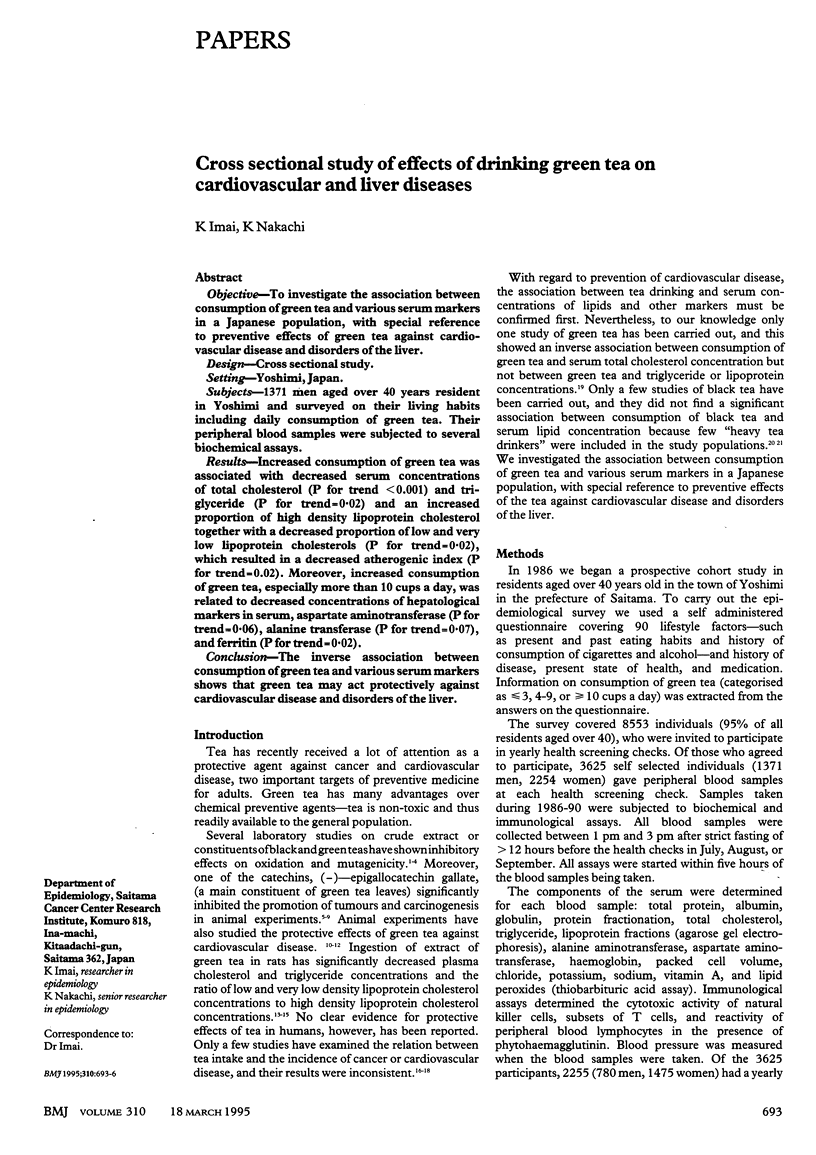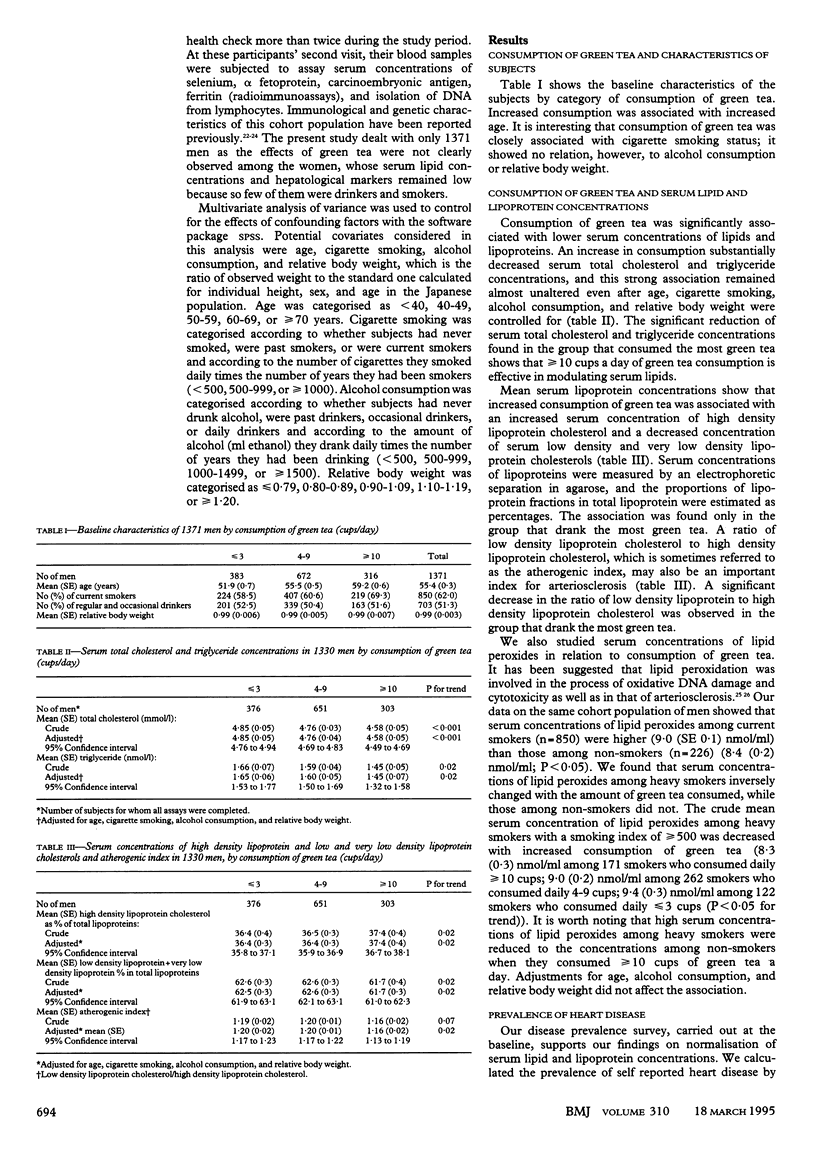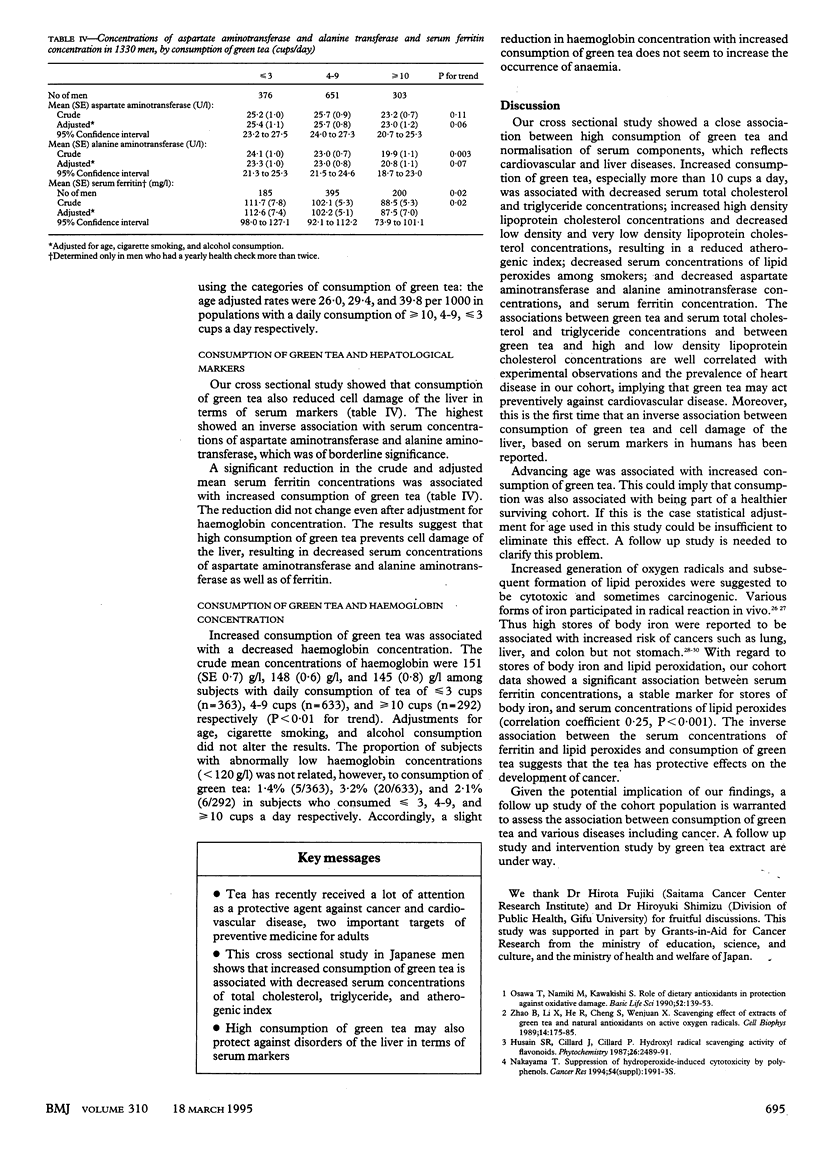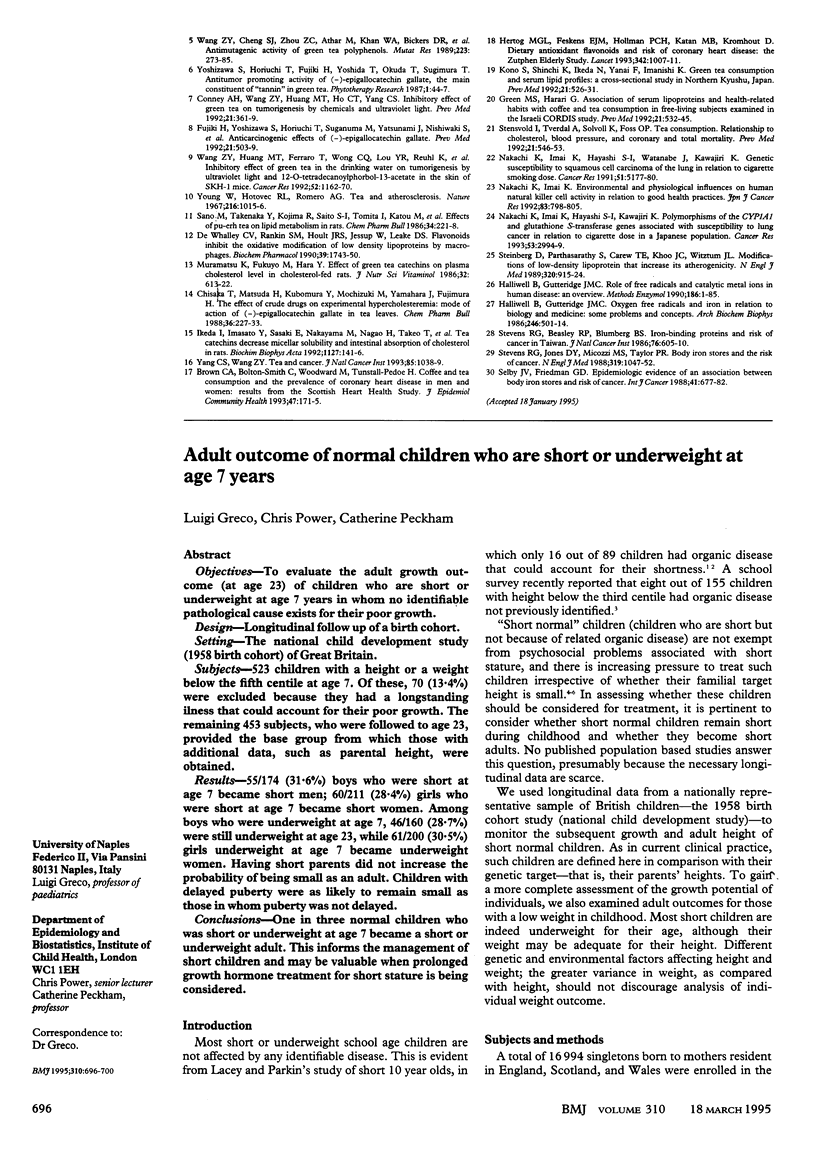Abstract
OBJECTIVE--To investigate the association between consumption of green tea and various serum markers in a Japanese population, with special reference to preventive effects of green tea against cardiovascular disease and disorders of the liver. DESIGN--Cross sectional study. SETTING--Yoshimi, Japan. SUBJECTS--1371 men aged over 40 years resident in Yoshimi and surveyed on their living habits including daily consumption of green tea. Their peripheral blood samples were subjected to several biochemical assays. RESULTS--Increased consumption of green tea was associated with decreased serum concentrations of total cholesterol (P for trend < 0.001) and triglyceride (P for trend = 0.02) and an increased proportion of high density lipoprotein cholesterol together with a decreased proportion of low and very low lipoprotein cholesterols (P for trend = 0.02), which resulted in a decreased atherogenic index (P for trend = 0.02). Moreover, increased consumption of green tea, especially more than 10 cups a day, was related to decreased concentrations of hepatological markers in serum, aspartate aminotransferase (P for trend = 0.06), alanine transferase (P for trend = 0.07), and ferritin (P for trend = 0.02). CONCLUSION--The inverse association between consumption of green tea and various serum markers shows that green tea may act protectively against cardiovascular disease and disorders of the liver.
Full text
PDF



Selected References
These references are in PubMed. This may not be the complete list of references from this article.
- Brown C. A., Bolton-Smith C., Woodward M., Tunstall-Pedoe H. Coffee and tea consumption and the prevalence of coronary heart disease in men and women: results from the Scottish Heart Health Study. J Epidemiol Community Health. 1993 Jun;47(3):171–175. doi: 10.1136/jech.47.3.171. [DOI] [PMC free article] [PubMed] [Google Scholar]
- Chisaka T., Matsuda H., Kubomura Y., Mochizuki M., Yamahara J., Fujimura H. The effect of crude drugs on experimental hypercholesteremia: mode of action of (-)-epigallocatechin gallate in tea leaves. Chem Pharm Bull (Tokyo) 1988 Jan;36(1):227–233. doi: 10.1248/cpb.36.227. [DOI] [PubMed] [Google Scholar]
- Conney A. H., Wang Z. Y., Huang M. T., Ho C. T., Yang C. S. Inhibitory effect of green tea on tumorigenesis by chemicals and ultraviolet light. Prev Med. 1992 May;21(3):361–369. doi: 10.1016/0091-7435(92)90043-h. [DOI] [PubMed] [Google Scholar]
- Fujiki H., Yoshizawa S., Horiuchi T., Suganuma M., Yatsunami J., Nishiwaki S., Okabe S., Nishiwaki-Matsushima R., Okuda T., Sugimura T. Anticarcinogenic effects of (-)-epigallocatechin gallate. Prev Med. 1992 Jul;21(4):503–509. doi: 10.1016/0091-7435(92)90057-o. [DOI] [PubMed] [Google Scholar]
- Green M. S., Harari G. Association of serum lipoproteins and health-related habits with coffee and tea consumption in free-living subjects examined in the Israeli CORDIS Study. Prev Med. 1992 Jul;21(4):532–545. doi: 10.1016/0091-7435(92)90061-l. [DOI] [PubMed] [Google Scholar]
- Halliwell B., Gutteridge J. M. Oxygen free radicals and iron in relation to biology and medicine: some problems and concepts. Arch Biochem Biophys. 1986 May 1;246(2):501–514. doi: 10.1016/0003-9861(86)90305-x. [DOI] [PubMed] [Google Scholar]
- Halliwell B., Gutteridge J. M. Role of free radicals and catalytic metal ions in human disease: an overview. Methods Enzymol. 1990;186:1–85. doi: 10.1016/0076-6879(90)86093-b. [DOI] [PubMed] [Google Scholar]
- Hertog M. G., Feskens E. J., Hollman P. C., Katan M. B., Kromhout D. Dietary antioxidant flavonoids and risk of coronary heart disease: the Zutphen Elderly Study. Lancet. 1993 Oct 23;342(8878):1007–1011. doi: 10.1016/0140-6736(93)92876-u. [DOI] [PubMed] [Google Scholar]
- Husain A., Bumpus F. M., De Silva P., Speth R. C. Localization of angiotensin II receptors in ovarian follicles and the identification of angiotensin II in rat ovaries. Proc Natl Acad Sci U S A. 1987 Apr;84(8):2489–2493. doi: 10.1073/pnas.84.8.2489. [DOI] [PMC free article] [PubMed] [Google Scholar]
- Ikeda I., Imasato Y., Sasaki E., Nakayama M., Nagao H., Takeo T., Yayabe F., Sugano M. Tea catechins decrease micellar solubility and intestinal absorption of cholesterol in rats. Biochim Biophys Acta. 1992 Jul 29;1127(2):141–146. doi: 10.1016/0005-2760(92)90269-2. [DOI] [PubMed] [Google Scholar]
- Kono S., Shinchi K., Ikeda N., Yanai F., Imanishi K. Green tea consumption and serum lipid profiles: a cross-sectional study in northern Kyushu, Japan. Prev Med. 1992 Jul;21(4):526–531. doi: 10.1016/0091-7435(92)90060-u. [DOI] [PubMed] [Google Scholar]
- Muramatsu K., Fukuyo M., Hara Y. Effect of green tea catechins on plasma cholesterol level in cholesterol-fed rats. J Nutr Sci Vitaminol (Tokyo) 1986 Dec;32(6):613–622. doi: 10.3177/jnsv.32.613. [DOI] [PubMed] [Google Scholar]
- Nakachi K., Imai K. Environmental and physiological influences on human natural killer cell activity in relation to good health practices. Jpn J Cancer Res. 1992 Aug;83(8):798–805. doi: 10.1111/j.1349-7006.1992.tb01983.x. [DOI] [PMC free article] [PubMed] [Google Scholar]
- Nakachi K., Imai K., Hayashi S., Kawajiri K. Polymorphisms of the CYP1A1 and glutathione S-transferase genes associated with susceptibility to lung cancer in relation to cigarette dose in a Japanese population. Cancer Res. 1993 Jul 1;53(13):2994–2999. [PubMed] [Google Scholar]
- Nakachi K., Imai K., Hayashi S., Watanabe J., Kawajiri K. Genetic susceptibility to squamous cell carcinoma of the lung in relation to cigarette smoking dose. Cancer Res. 1991 Oct 1;51(19):5177–5180. [PubMed] [Google Scholar]
- Osawa T., Namiki M., Kawakishi S. Role of dietary antioxidants in protection against oxidative damage. Basic Life Sci. 1990;52:139–153. doi: 10.1007/978-1-4615-9561-8_11. [DOI] [PubMed] [Google Scholar]
- Sano M., Takenaka Y., Kojima R., Saito S., Tomita I., Katou M., Shibuya S. Effects of pu-erh tea on lipid metabolism in rats. Chem Pharm Bull (Tokyo) 1986 Jan;34(1):221–228. doi: 10.1248/cpb.34.221. [DOI] [PubMed] [Google Scholar]
- Selby J. V., Friedman G. D. Epidemiologic evidence of an association between body iron stores and risk of cancer. Int J Cancer. 1988 May 15;41(5):677–682. doi: 10.1002/ijc.2910410507. [DOI] [PubMed] [Google Scholar]
- Steinberg D., Parthasarathy S., Carew T. E., Khoo J. C., Witztum J. L. Beyond cholesterol. Modifications of low-density lipoprotein that increase its atherogenicity. N Engl J Med. 1989 Apr 6;320(14):915–924. doi: 10.1056/NEJM198904063201407. [DOI] [PubMed] [Google Scholar]
- Stensvold I., Tverdal A., Solvoll K., Foss O. P. Tea consumption. relationship to cholesterol, blood pressure, and coronary and total mortality. Prev Med. 1992 Jul;21(4):546–553. doi: 10.1016/0091-7435(92)90062-m. [DOI] [PubMed] [Google Scholar]
- Stevens R. G., Beasley R. P., Blumberg B. S. Iron-binding proteins and risk of cancer in Taiwan. J Natl Cancer Inst. 1986 Apr;76(4):605–610. doi: 10.1093/jnci/76.4.605. [DOI] [PubMed] [Google Scholar]
- Stevens R. G., Jones D. Y., Micozzi M. S., Taylor P. R. Body iron stores and the risk of cancer. N Engl J Med. 1988 Oct 20;319(16):1047–1052. doi: 10.1056/NEJM198810203191603. [DOI] [PubMed] [Google Scholar]
- Wang Z. Y., Cheng S. J., Zhou Z. C., Athar M., Khan W. A., Bickers D. R., Mukhtar H. Antimutagenic activity of green tea polyphenols. Mutat Res. 1989 Jul;223(3):273–285. doi: 10.1016/0165-1218(89)90120-1. [DOI] [PubMed] [Google Scholar]
- Wang Z. Y., Huang M. T., Ferraro T., Wong C. Q., Lou Y. R., Reuhl K., Iatropoulos M., Yang C. S., Conney A. H. Inhibitory effect of green tea in the drinking water on tumorigenesis by ultraviolet light and 12-O-tetradecanoylphorbol-13-acetate in the skin of SKH-1 mice. Cancer Res. 1992 Mar 1;52(5):1162–1170. [PubMed] [Google Scholar]
- Yang C. S., Wang Z. Y. Tea and cancer. J Natl Cancer Inst. 1993 Jul 7;85(13):1038–1049. doi: 10.1093/jnci/85.13.1038. [DOI] [PubMed] [Google Scholar]
- Young W., Hotovec R. L., Romero A. G. Tea and atherosclerosis. Nature. 1967 Dec 9;216(5119):1015–1016. doi: 10.1038/2161015a0. [DOI] [PubMed] [Google Scholar]
- Zhao B. L., Li X. J., He R. G., Cheng S. J., Xin W. J. Scavenging effect of extracts of green tea and natural antioxidants on active oxygen radicals. Cell Biophys. 1989 Apr;14(2):175–185. doi: 10.1007/BF02797132. [DOI] [PubMed] [Google Scholar]
- de Whalley C. V., Rankin S. M., Hoult J. R., Jessup W., Leake D. S. Flavonoids inhibit the oxidative modification of low density lipoproteins by macrophages. Biochem Pharmacol. 1990 Jun 1;39(11):1743–1750. doi: 10.1016/0006-2952(90)90120-a. [DOI] [PubMed] [Google Scholar]


